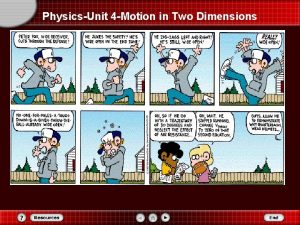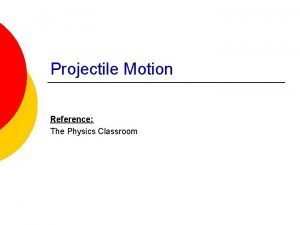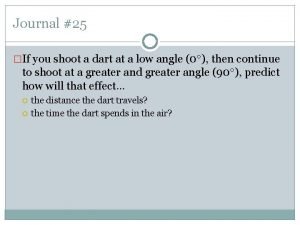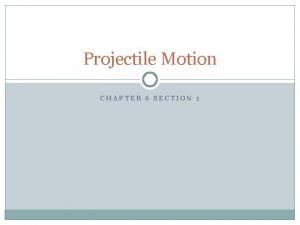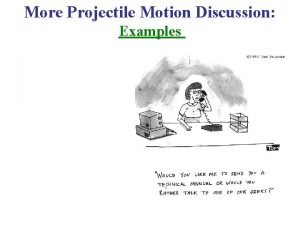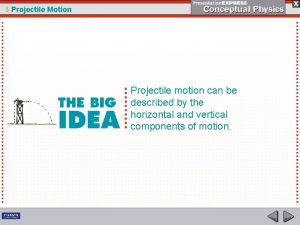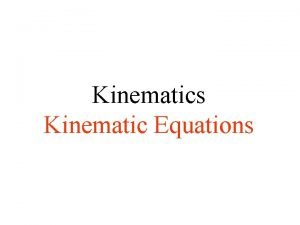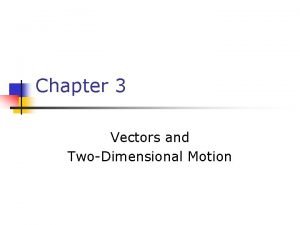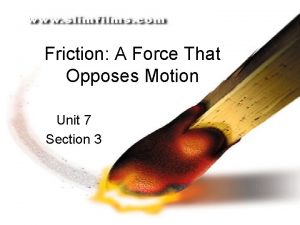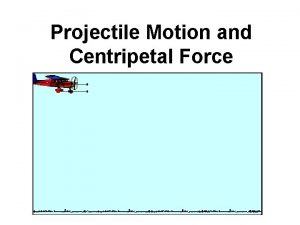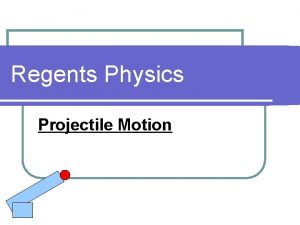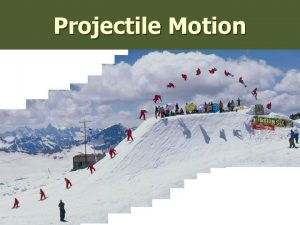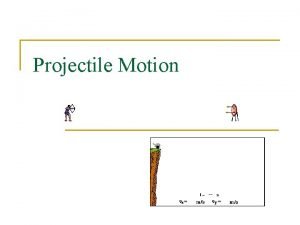Projectile Motion What is a projectile A projectile












- Slides: 12

Projectile Motion

What is a projectile? A projectile is an object moving in two dimensions under the influence of Earth's gravity; its path is a parabola.

What is a projectile? • A projectile is an object upon which the only force acting is gravity. A projectile is any object which once projected or dropped continues in motion by its own inertia and is influenced only by the downward force of gravity.

3 -7 Projectile Motion The speed in the x-direction is constant; in the y-direction the object moves with constant acceleration g. This photograph shows two balls that start to fall at the same time. The on the right has an initial speed in the x-direction. It can be seen that vertical positions of the two balls are identical at identical times, while the horizontal position of the yellow ball increases linearly.

Factors Influencing Projectile Trajectory: the flight path of a projectile • Angle of projection • Projection speed • Relative height of projection

Factors Influencing Projectile Trajectory Angle of Projection • General shapes – Perfectly vertical – Parabolic – Perfectly horizontal • Implications in sports • Air resistance may cause irregularities

Projectile Motion It can be understood by analyzing the horizontal and vertical motions separately.

Solving Problems Involving Projectile Motion 1. Read the problem carefully. 2. Draw a diagram. 3. List what you know from the problem and what you need to solve for. 4. Determine which equations for vertical motion or horizontal motion will help you solve the problem. You may need more than one equation. 5. Examine the x and y motions separately. 6. Solve the problem and check your work.

Equations for Projectile Motion Horizontal distance: ∆Xx= vxt Vertical velocity: vy=at (a=g=9. 8 m/s 2) Vertical distance: ∆xy= 1/2 at 2 (a=g=9. 8 m/s 2)

A movie stunt driver on a motorcycle speeds horizontally off a 50. 0 m-high cliff. How fast must the motorcycle leave the cliff top to land on level ground below, 90. 0 m from the base of the cliff where the cameras are? Ignore air resistance. vx = ? = 28. 21 ∆xy = 50 m t = ? = 3. 19 ∆xx = 90 m a = g = 9. 8 m/s 2 ∆Xx= vxt ∆Xx/t = vx vx = ∆Xx/t vx = 90/3. 19 2 ∆xy= 1/2 at vx = 28. 21 ∆xy/(1/2 a) = t t = ∆xy/(1/2 a) t = 50/(1/2(9. 8)) t = 50/(4. 9) t = 3. 19

y A boy runs at a speed of 3. 3 m/s straight off the end of a diving board that is 3 m above the water. How long is he airborne before he hits the water? What is the horizontal distance he travels while in the air? vx = 3. 3 m/s ∆xy = 3 m t = ? =. 78 s ∆xx = ? = 2. 574 m a = g = 9. 8 m/s 2 2 ∆x∆X = 1/2 at = v t y x x ∆x ∆Xxy=/(1/2 a) 3. 3 x. 78= t t ∆X = ∆x x= 2. 574 y/(1/2 a) t = 3/(1/2(9. 8)) t = 3/(4. 9) t =. 78 x

Summary • A projectile is a body in free fall that is affect only by gravity and air resistance (which we are ignoring). • Projectile motion is analyzed in terms of its horizontal and vertical components. – Vertical is affected by gravity • Factors that determine the height & distance of a projectile are; projection angle, projection speed, and relative projection height
 Objects that exhibit projectile motion follow a path.
Objects that exhibit projectile motion follow a path. Hewitt
Hewitt Ballistics formulas
Ballistics formulas The path of a projectile is called its
The path of a projectile is called its Symmetrical projectile motion
Symmetrical projectile motion Projectile motion review
Projectile motion review Symmetrical projectile motion
Symmetrical projectile motion A long jumper leaves the ground at an angle of 45
A long jumper leaves the ground at an angle of 45 V^2 sin 2 theta/g
V^2 sin 2 theta/g Projectile motion
Projectile motion Kinematic equations examples
Kinematic equations examples Non-projectile motion
Non-projectile motion A force that opposes motion of a projectile
A force that opposes motion of a projectile
